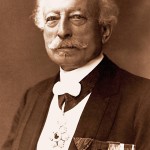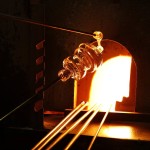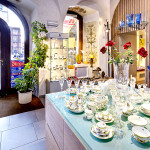This is a story of artisans. It all started during the period of the Empire, on its periphery. At the time it was called Karlsbad, Karlovy Vary, when Bohemia was the last northern region of the Great Austria-Hungarian Empire. This story is one of objects, made by hand, designed and created inside two rooms in a shop. Or at least, that’s how the crystal world adventure of Ludwig Moser started a hundred and sixty years ago.
It was the year 1857, when in the city of the “Charles thermae”, this young German – of Jewish origin – founded the Ludwig Moser & Söhne, a laboratory for polishing and engraving glass, which was produced in that region. The coordinates of these events are non fortuitous: in the words of Brodsky «there are places where geography creates history», and this was the case with this land which, already during the Middle Age, had made the production and processing of glass, one of its major sectors of production. At first it was done to produce everyday objects, then in the fifteenth century, the German glass market entered into direct competition with the production of decorated glazed Venetian crystal. It was then that out of pure necessity, determined by the laws of the market, (necessity is the mother of all inventions), the Bohemian artisans are able to fight back: admiration, observation, hard work which enabled them to equal, improve and, eventually, prevail over the crystal being produced in the Laguna.
The new formula required the production of a more potassic and stronger glass, compared to the Venetian type, that would endure incisions on the wheel. As the years went by, adjustments were made to the formulas and materials used in its production: a further step forward was the addition of calcium carbonate, used as a stabilizer in the compound. The eighteenth century marks the beginning of exports to America, southern Europe, Scandinavia and Russia, which were to increase steadily over the years. Thus, with this legacy, Moser began to carve his glass. The first success came from the capital: at the International Exhibition in Vienna in 1873, his crystal creations are rewarded for their quality and the beauty of the engraving. But it’s not a promising start.
 The real turning point was to come two decades later, in 1893, when Ludwig Moser took over the reins of a factory in Karlovy Vary, which produced glass, registering it under the name of Karlsbaderglasindustrie Gesellschaft Ludwig Moser & Söhne. The new company – which since its very beginning – employed four hundred workers, started producing Bohemian lead-free crystal pieces, according to a formula that uses calcium and potassium. The finished product is lighter, less reflective, and of an extraordinary brightness. These features, together with carvings and gold flower engravings, became the unmistakable signature of this artistic production. The company, which also employed Ludwig Moser’s two sons, Gustav and Rudolf, soon became a point of reference for European and global processing and export of precious crystal objects: glasses of different shapes and colours, jugs, plates and vases. In 1901 the Bohemian company, expanded into the East and Moser became the exclusive supplier of crystal to the Shah of Persia. In just a few years, even Europe became convinced and was conquered by the fragile and luminous beauty of these objects: First, in 1904, by the Emperor of Austria, then, four years later, by the court of England – ruled by King Edward VII – that chose to fill its living rooms with crystal produced in Karlovy Vary. In 1910, besides their engraving and cutting work, etched decor hallmarked in gold, began to be produced.
The real turning point was to come two decades later, in 1893, when Ludwig Moser took over the reins of a factory in Karlovy Vary, which produced glass, registering it under the name of Karlsbaderglasindustrie Gesellschaft Ludwig Moser & Söhne. The new company – which since its very beginning – employed four hundred workers, started producing Bohemian lead-free crystal pieces, according to a formula that uses calcium and potassium. The finished product is lighter, less reflective, and of an extraordinary brightness. These features, together with carvings and gold flower engravings, became the unmistakable signature of this artistic production. The company, which also employed Ludwig Moser’s two sons, Gustav and Rudolf, soon became a point of reference for European and global processing and export of precious crystal objects: glasses of different shapes and colours, jugs, plates and vases. In 1901 the Bohemian company, expanded into the East and Moser became the exclusive supplier of crystal to the Shah of Persia. In just a few years, even Europe became convinced and was conquered by the fragile and luminous beauty of these objects: First, in 1904, by the Emperor of Austria, then, four years later, by the court of England – ruled by King Edward VII – that chose to fill its living rooms with crystal produced in Karlovy Vary. In 1910, besides their engraving and cutting work, etched decor hallmarked in gold, began to be produced.
1923 was a “miraculous year”: two hundred and thirteen pieces of the Pope collection were donated to Pope Pius XI during his accession to the papal throne. The rest belongs to recent history, which is no less resounding. Despite the difficulties caused by the great economic depression of the thirties, that obliged it to drastically reduce its staff, its crystal maintained a constant inimitable quality. In 1940 the “Grand Prix Diploma”, is awarded to the Czechoslovakian company at the Milan Biennial. In 1947, the Splendid table-set is offered as a wedding gift to Queen Elizabeth II of England. The brand is so well established that not even the iron hand of the communist regime, with the nationalization of all industries in 1948, was able to destroy or downgrade production. Unique pieces continued to be exposed and awarded throughout Europe: France, England, Belgium, Austria and Italy. The international fame was to gain the company the epithet of “King of Glass, Glass of Kings”. And also of Presidents, one might add, because coming back to the present day, recently the Czech Prime Minister Peter Nečas – during a meeting with Barack Obama – offered his White-House guest a set of Moser glasses and a carafe, highlighting the fact that these products “are the best way to represent the Czech Republic around the world”.
Besides, not even the hardship of the recent economic crisis has been able to shatter the fortune of Bohemian crystal. After a few difficult years, in 2011, the company began to recover and started making profits, which amounted to millions of crowns, thanks to renewed interest in traditional markets, such as Europe, the United States and to a substantial growth of exports to Russia, China and Japan. But it is not only Karlovy Vary’s company that started raising its head, but also the Czech glass industry as a whole, which is going through a new spring experience. In 2012, total turnover of Czech companies reached over forty billion crowns, about one and a half billion euro, with an increase of eight per cent over the previous year, a threshold that had previously been exceeded only in 2008, the year in which the crisis began.
It was the Moser company, in fact, with its two single-brand stores in the centre of Prague, and premises at Karlovy Vary to become, in 2011, part of the prestigious Comité Colbert, the French association that groups seventy-five major brands of French luxury. Moser is the first and only Czech company to be admitted into the club. Because no one stands higher than the king.
by Edoardo Malvenuti








